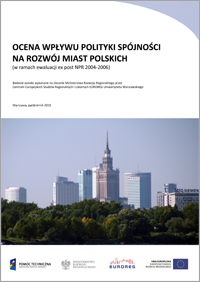
Ocena wpływu polityki spójności na rozwój miast polskich (w ramach ewaluacji ex post NPR 2004-2006)
STRESZCZENIE
Głównym celem badania była ocena wpływu polityki spójności w okresie programowania 2004-2006 na rozwój polskich miast i ich relacje z otoczeniem regionalnym. Badanie objęło wszystkie polskie miasta o liczbie ludności przekraczającej 90 tys. W przypadku konurbacji miejskich analizowano łącznie wszystkie miasta wchodzące w ich skład. W efekcie badaniem objęto 31 miast oraz 2 konurbacje: śląską i trójmiejską. 5 miast zostało poddanych bardziej szczegółowym analizom w ramach studiów przypadku (Warszawa, Poznao, Lublin, Zielona Góra, Rybnik). Badanie dotyczyło trzech głównych aspektów: (1) konkurencyjności i atrakcyjności, (2) spójności społecznej i przestrzennej (suburbanizacja i rewitalizacja), (3) dyfuzji procesów rozwojowych w otoczeniu miast.
ABSTRACT
The main purpose of the survey was to assess the influence of the cohesion policy in the 2004-2006 programming period on the development of Polish cities and their relations with regional surroundings. The survey covered all Polish cities with a population exceeding 90 thousand. In the event of urban conurbations all constituent cities were analysed together. In the end the survey covered 31 cities and 2 conurbations: the Silesian and the Tricity ones. 5 cities were analysed in greater detail by means of case studies (Warsaw, Poznao, Lublin, Zielona Góra and Rybnik). The survey examined three main aspects: (1) competitiveness and attractiveness, (2) social and spatial cohesion (suburbanization and renewal) and (3) diffusion of development processes in the surrounding of cities.




